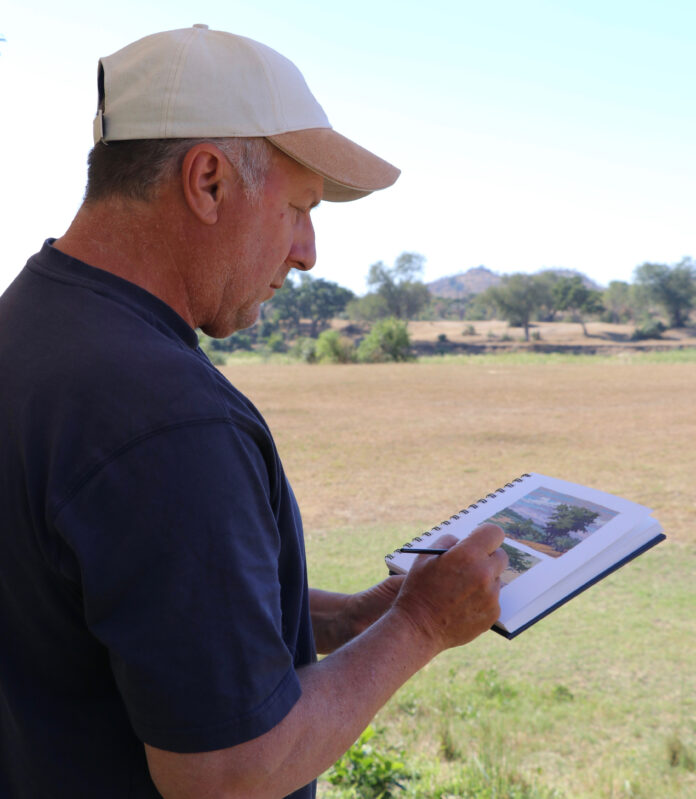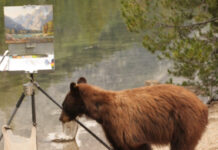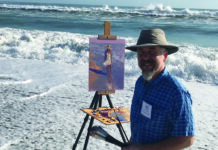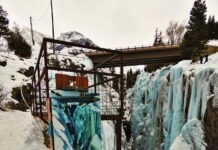Follow along as Paul Kratter shares his adventures painting with gouache on safari. Editor’s Note: Paul’s new workshop, “Landscape Painting & Design,” is about how to master the design, the most critical part of your painting, and how to apply it to create a successful landscape painting. Learn more here.
I once visited three South Africa game reserves in two weeks. Along with my wife, Tia, I took sons Joel and Marsh; daughter-in-law, Andrea; and my sketching supplies. Although the aim of the trip was to see as many animals as possible, my artistic goals centered around the landscape. Pulled straight from my journal and sketchbook, the pages that follow give you a taste of our experience.
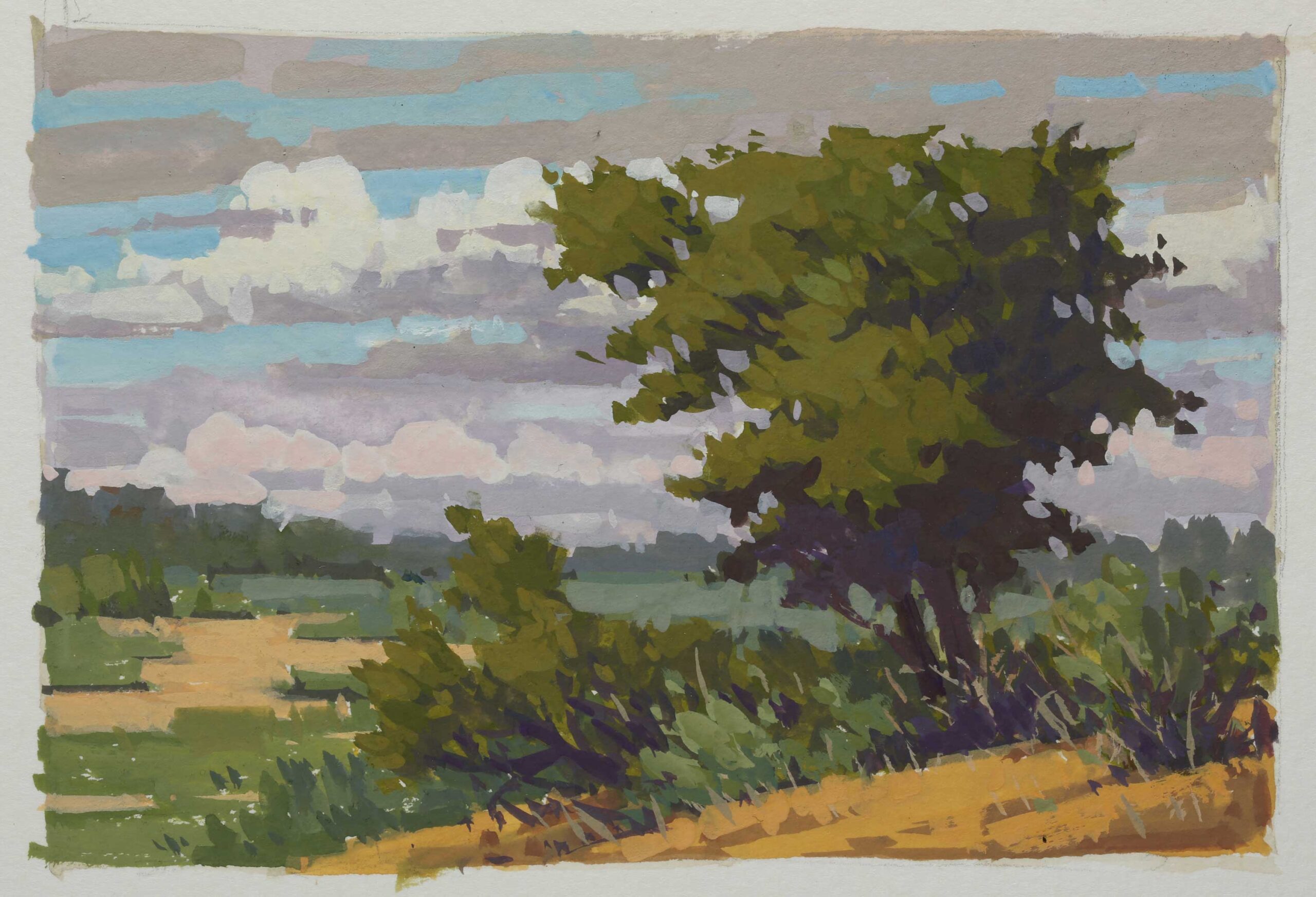
Day 1 – Arriving at Mala Mala Game Reserve
And so it begins!
In the morning, we take a short flight from Johannesburg to Mala Mala. At the reserve, I unpack quickly, and there’s just time to make a quick sketch. A large jackalberry tree sits above the Sand River; its unique shape draws me in. As I paint from my view at the lodge, three giraffes and a number of impala feed. A waterbuck and a skittish warthog wander by the riverbank, and a large saddleback stork lands in a nearby tree.
I’ve chosen to bring gouache on this trip because it’s easy to set up — no messy oils or wet panels, and no looking for turpenoid or a place to toss out dirty paper towels. Working with this medium on location is so immediate as well. I can paint transparent washes or go in directly with an opaque color. Gouache also cleans up with water and doesn’t require an easel; I can simply paint on my lap if need be.
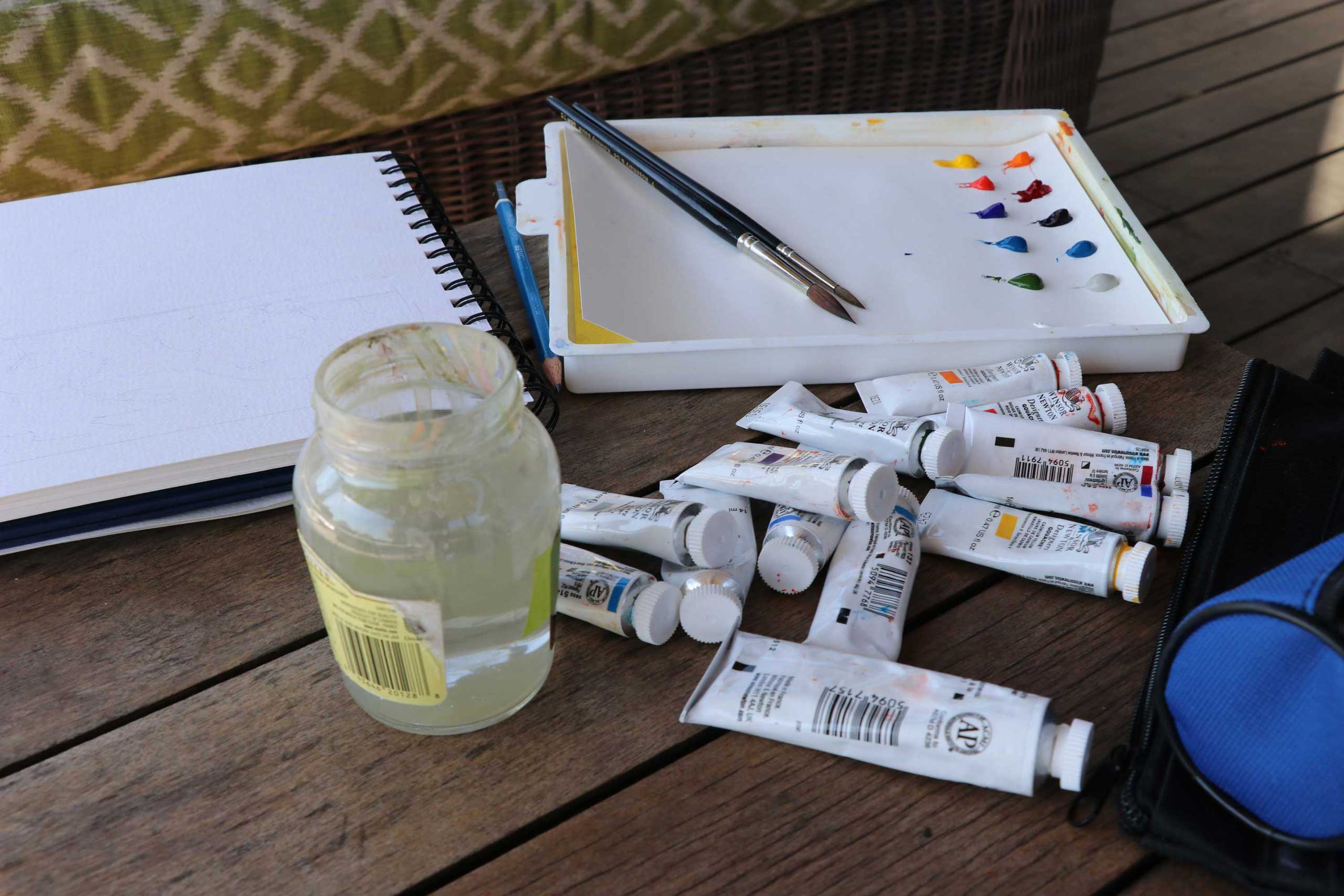
Our guide, Cameron, arrives and it’s time for our first game drive. He wants to find two cheetahs who made a kill earlier in the day, but then lost it to a hyena. We spot them in the tall grass, blending almost imperceptibly into their surroundings.
We’re then treated to the magnificent sight of a mother leopard and her two cubs — so graceful, sleek, and strong. Much to Cameron’s delight, one of the cubs catches and kills a highly venomous puff adder. It pounces on the snake and even plays with it for a while. Darkness falls, and we head back to camp.
Day 2 – Mala Mala
Our game drive starts at sunrise and we come upon two male rhinos feeding peacefully together — an unusual sight, especially as they are of different ages, and males can be aggressive toward one another.
After the morning drive, I make two vertical paintings depicting the views of the Sand River as it winds past the lodge. Tall reeds line the shore and can hide whole herds of animals as they come down to drink. Painting at the lodge means I can find shade if I like, with the added benefit that someone on staff might come by and offer me a cool drink of my own while I work.
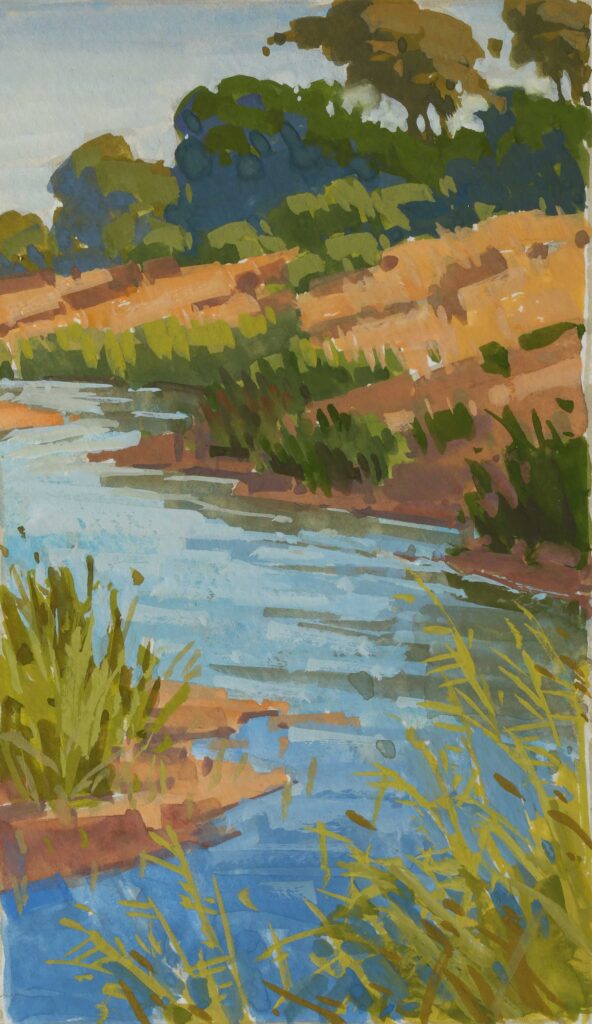
This evening, we try to find part of a lion pride, but they’ve been elusive so far. We see two owls — a large Verreaux’s eagle-owl and a small white-faced owl. Right at sundown, we spot a white rhino bathed in the warm light.
Day 3 – Mala Mala
We set out again with the hope of seeing the lions. Instead, we find a large herd of elephants composed of females and a few small calves. The young ones cavort about, rolling in the sand, chasing each other, and trying to figure out how their trunks work. We also spot greater kudu, nyala, and duikers close by.
On a night drive, we shine a spotlight into the trees, trying to get the eye shine off any nocturnal creatures. We spy a civet, a small curious-looking animal — part raccoon, part weasel, and part cat. He seems to pose for us, letting us get a good look before disappearing into the brush.
Day 4 – Mala Mala
Cameron interrupts our breakfast: “Grab your gear! There’s a pack of Cape hunting dogs just across the river.” We run to the vehicle and take off, catching up to the dogs as they rest in the brush. In an instant, they’re off again, scattering in all directions. We follow a couple of dogs and end up by the river. One of them has killed an impala and is already feeding; vultures gather nearby. When she has her fill, the vultures descend to get their share of the free meal. Soon, the rest of the pack shows up, chases away the scavengers, and finishes off the carcass.
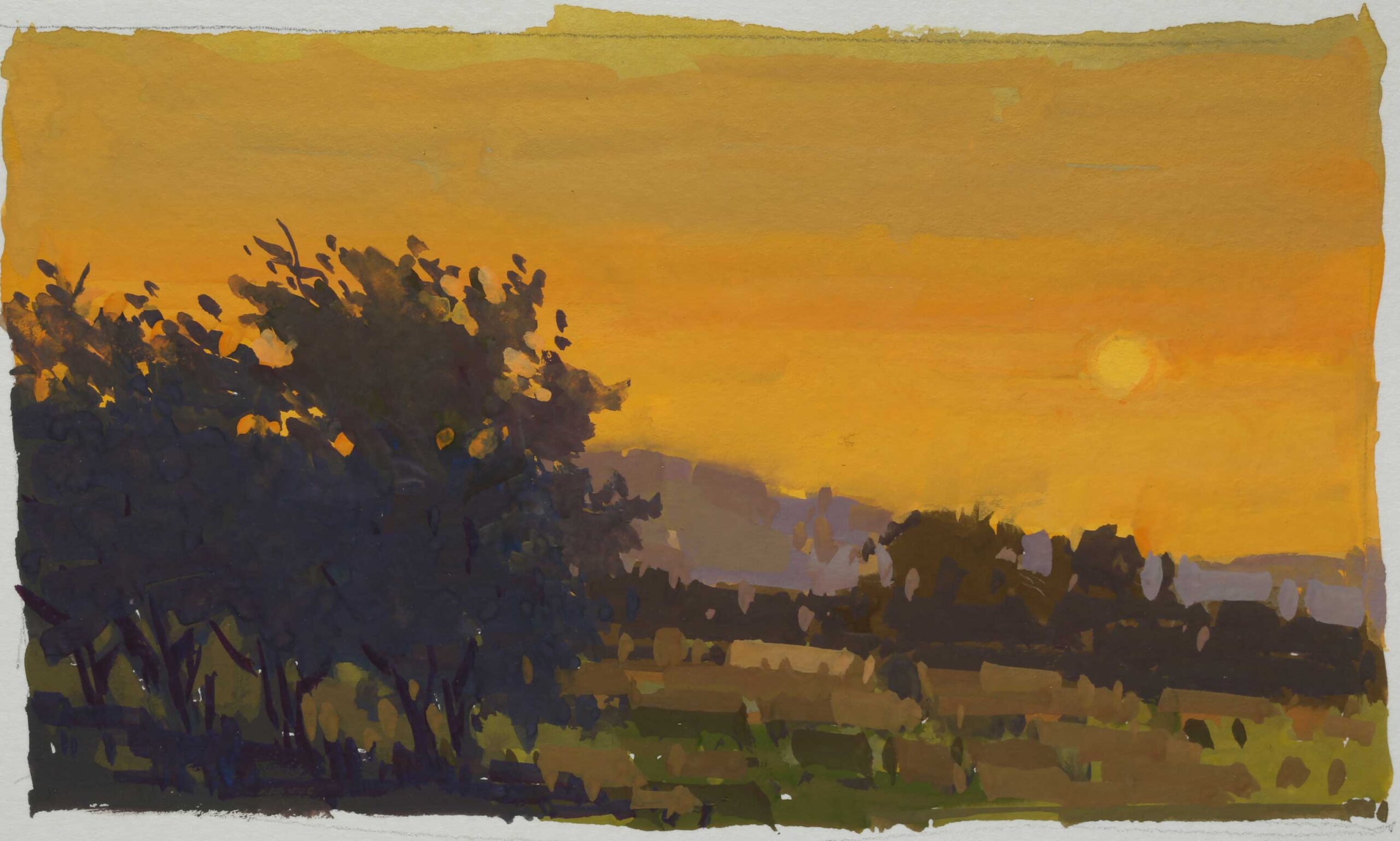
Day 5 – Mala Mala
Before the family wakes up, I go out to paint at sunrise. It’s winter in South Africa, so it’s pretty chilly this early in the morning, but it typically warms up to the mid-70s during the day. The gouache is working out well, as it never gets so hot here that the paint dries too quickly. Interestingly, I’ve not been bothered at all by bugs.
On our afternoon drive, we stake out the spot where a female leopard has stashed her impala kill in a tree. It takes a while, but she finally appears, making her way to the tree in a few graceful bounds. She feeds for a good 10 minutes, tearing off chunks of meat with her powerful jaws.
Day 6 – Arriving at Phinda Game Reserve
We leave Mala Mala for Phinda this morning. The two bumpy flights don’t sit well with Joel and Marsh, and we’re all glad to be back on terra firma. We settle in and meet our guide, Oli, and tracker, Jabs, for our first drive.
Phinda is known for its cheetahs, and it doesn’t take long for us to spot a female and her two 9-month-old cubs. Although they’re almost full-grown, with just a bit of ruff on the backs of their necks, they’re still too young to hunt on their own.
Day 7 – Phinda
This morning we set out to find the cheetah family once more, and before long, Marsh spots them on a small rise off the dusty road. We follow them for quite a while until they seek cover under a thorny bush. We catch up to the trio again later in the day when Jabs and Oli recognize fresh footprints in the sand. Suddenly three heads pop out from the shade of a bush. They have killed a young warthog and are feeding.
Back at the lodge, the silhouettes of the trees in a nearby grove inspire me to pull out my paints and capture the graphic scene. Clouds form and keep most of the foreground in shadow in “High Clouds.” Vervet monkeys keep me company, hoping to steal any food I leave unattended.
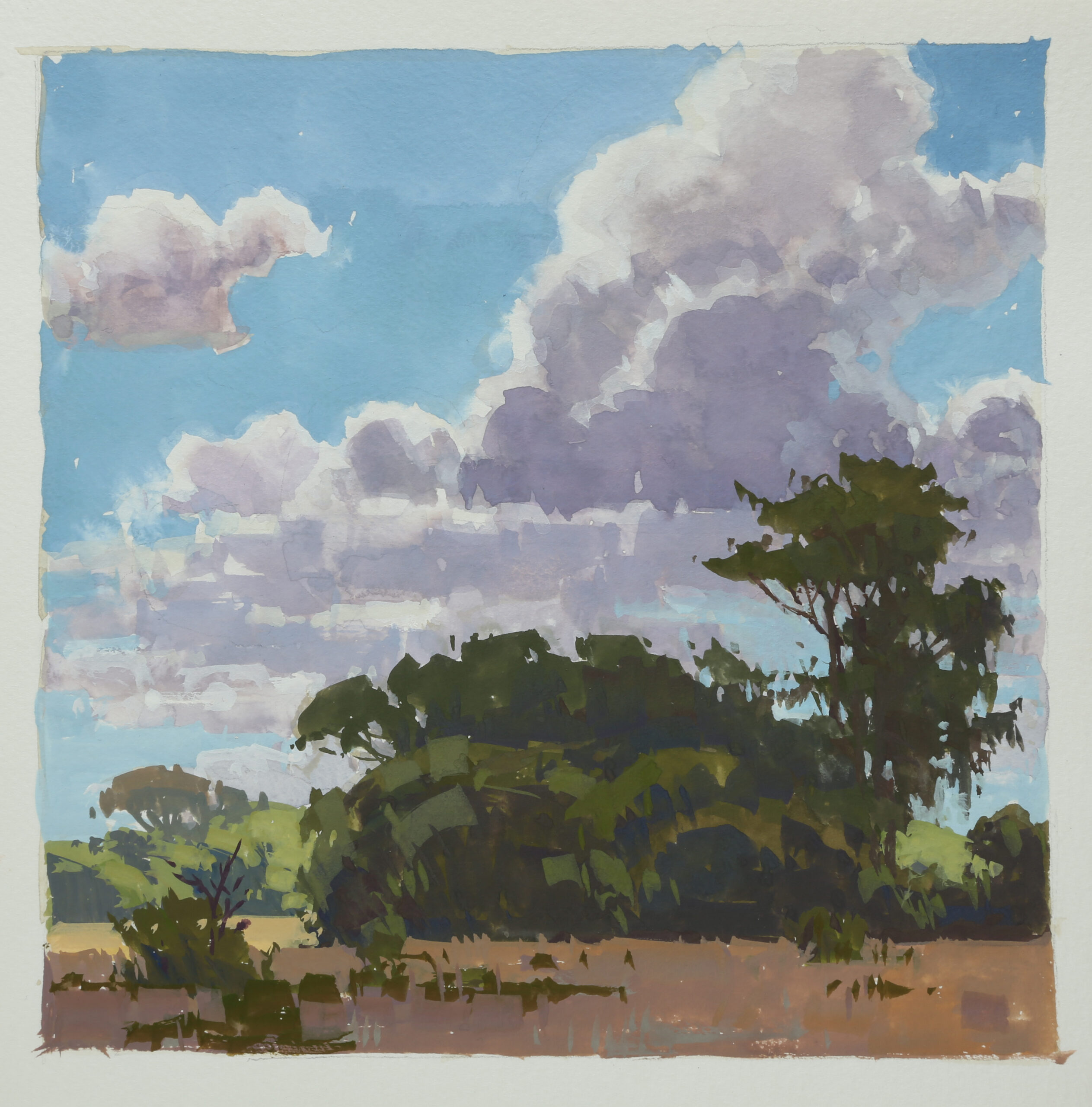
On our afternoon drive, we finally see the two adult male lions and two females we’ve been searching for. The males look magnificent with their large manes. Within a couple of minutes, they both plop down and don’t move again. The females are a bit more restless, but soon all four are fast asleep. One of the males has a large, fresh scar under its eye. The brothers may have scuffled with each other, or perhaps he has fought with a rival or even a hyena.
Day 8 – Phinda
After our morning outing, I make another sketch at the lodge, “Waning Shade.” I’m drawn to a couple of acacia trees that dot the savanna, with an open stretch of grassland between them. Two young nyala (a fairly large antelope) spar while I paint. Clear skies and a gentle breeze make for an idyllic scene.
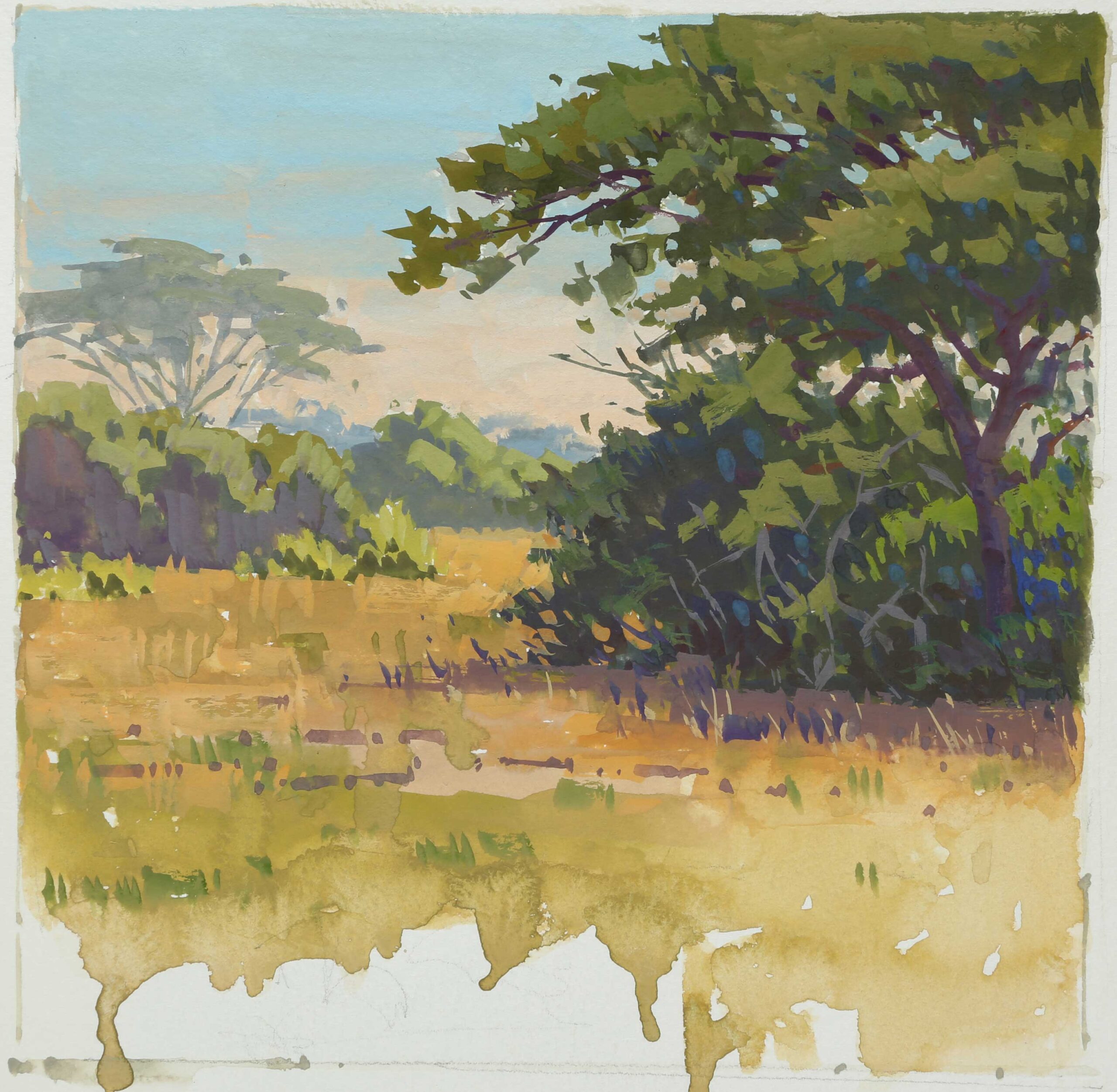
For our second drive of the day, the kids hire a guide to shoot video, using infrared light at night. After a long drive south, we come across a mother rhino and calf. In this park, the rangers safely remove the horns of adult rhinos, so they won’t be poached. This one, however, has not been dehorned, and she has a huge, magnificent horn.
Day 9 – Phinda
I’m up at dawn to capture the tree line on the horizon in the morning light. These sketches are for my own collection and won’t be sold, although I may make some larger oil paintings from the studies, perhaps with the wildlife we see on the trip.
Marsh and Andrea look out over the same scene and notice that two “bumps” have suddenly started moving — it’s a mother cheetah and her year-old cub. Cheetahs prefer the open grassland and can often be seen on termite mounds, scanning for prey or for lions who could kill them. Built for speed, cheetahs are thin, with enlarged chests for greater lung and heart capacity, a small head, a long tail that serves as a rudder, and non-retractable claws for traction.
On our morning drive, we come upon the cheetah pair on the road. Two duikers (small antelopes) cross the path ahead of them, oblivious to the danger. The cheetahs drop low. When the duikers finally catch wind of the threat, the mother cheetah bolts and they break for the forest, escaping after a short chase.
Day 10 – Arriving at Ngala Wildlife Reserve
Just as we head out for a sunrise coffee atop a distant hill on our last day in Phinda, we notice something on the road ahead. Cheetahs? Nyala? Lions! Two huge males come toward us down the road — it’s the two brothers, the one with the scar and his older sibling. They pass by us, just a few feet away.
We follow them back toward camp until they leave the road and head off into the brush and forest. Baboons overhead scream their alarm, warning others. The lions continue on, appearing once more just behind our lodge, then disappear again.
After our encounter with the lions, the sun comes up and lights the landscape in golden hues, which I capture in “Golden Morning.” This time of year, some of the deciduous trees in South Africa are changing colors, which adds interest to the painting. With oils, I typically block in the darks first to serve as a guidepost, but with gouache, I almost always work from back to front, so I need to plan a bit more.
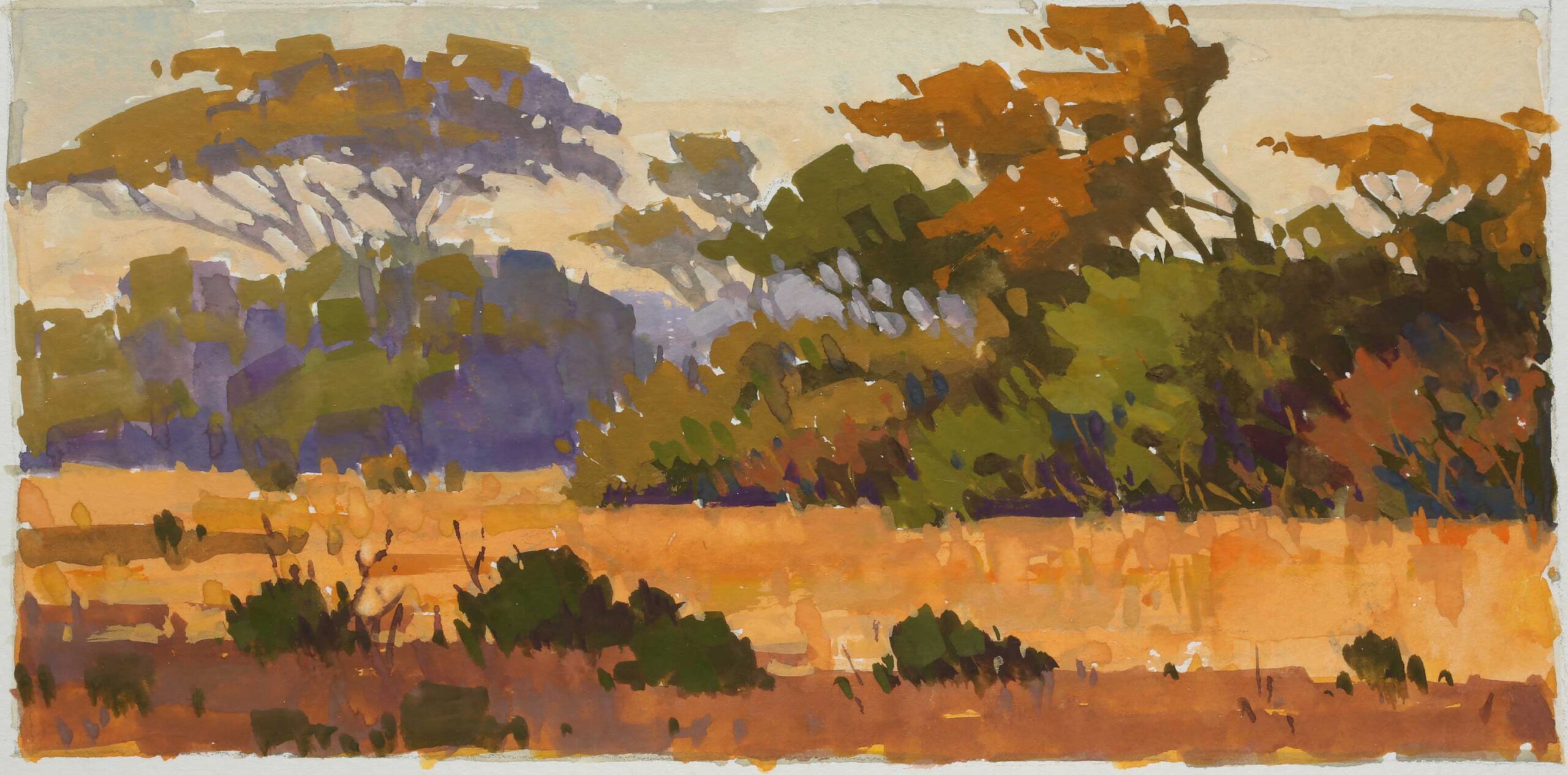
With the painting complete, it’s off to our final reserve, Ngala, where we meet our guide, Bernard, and tracker, Aubrey. Out on the open savanna on our first drive, we come across a whole pride of lions — one large male, a subadult male, a few females, and some cubs, including a rare white cub (the product of a genetic mutation). Moving just a short distance away, we find another lioness with four very young cubs, including another white one!
Lions look for secluded areas to give birth and hide their young, such as the jumble of rocks in “Rocky Lair.” The interesting formation of the rock shapes near a dry riverbed inspired me to make a quick sketch.
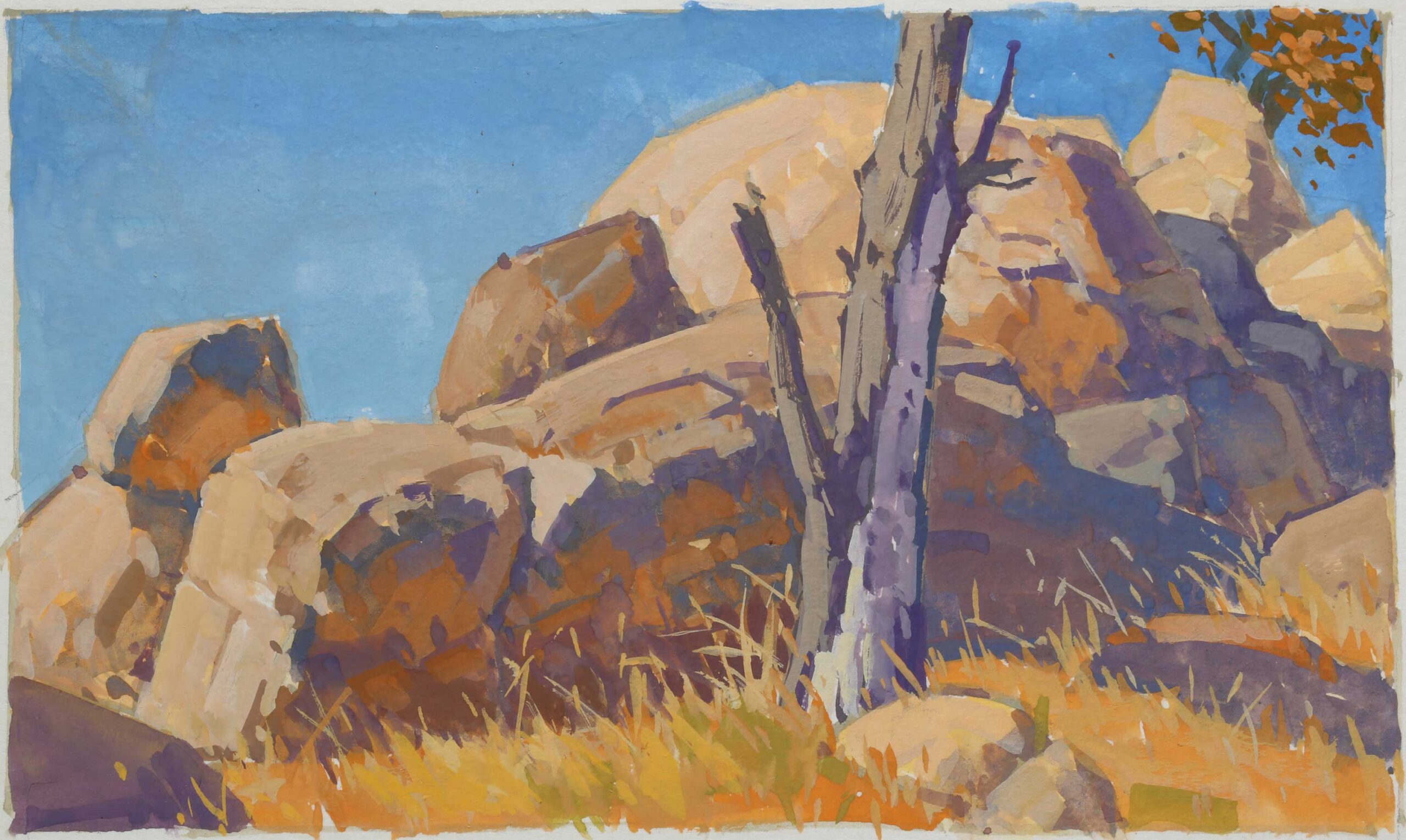
The sun sets as we drive back to the lodge. In the dark, our headlights illuminate an aardvark — an incredibly rare animal to see. In fact, our guide has only seen one other in the seven years he has been on the job. It’s a funny-looking animal, about the size of a pig and pinkish gray in color. It tears apart termite mounds with its long, sharp claws to get to the insects inside. It hops, then disappears in the darkness. We’re all stunned and giddy to see such an elusive creature.
Day 11 – Ngala
The morning’s drive takes us to a hyena den, where we spot a mother and two cubs, one older and one quite young. The little one is incredibly active; everything goes into its mouth — biting, chewing, and gnawing — even mom’s tail is fair game.
On our afternoon drive, we head to the site of another den. This time we’re looking for Cape hunting dogs. Four adults are resting just beyond the entrance to the den. Our guide knows they have puppies, but they are out of sight. We watch the adults for about 20 minutes when they suddenly bolt up and run to the den. There is a lot of commotion, then six to eight puppies appear. They all greet each other, then run off a short distance, out of sight.
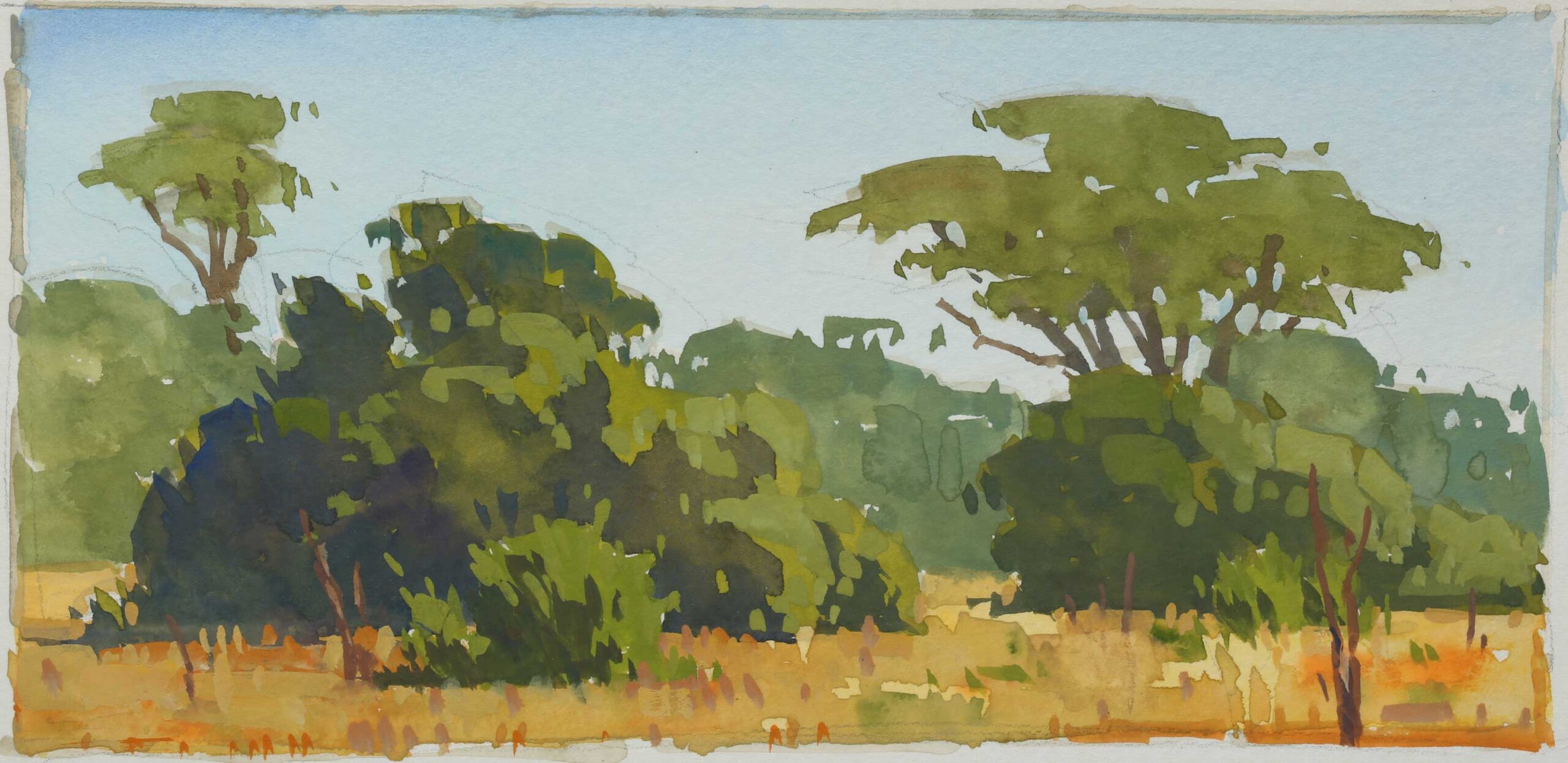
Day 12 – Heading Home
It’s our last day in South Africa. We stop to have coffee in a dry stream bed on our final morning drive. As we relax, a hyena comes out of the high bank and wanders past us seemingly without a care in the world.
Further up the river bed, we see three large male greater kudu feeding along the bank. Their magnificent spiral horns make this one of the more beautiful species of antelope.
Back at the lodge, we pack our bags and head to the airport. Two short flights, followed by two long ones, and we’re home — with more great memories than we ever could have expected, plus a lifetime of painting inspiration for me.
Learn what to put in, what to leave out, composition tips, design secrets Paul Kratter has learned throughout his 20+ years as a professional illustrator, and much more when you get his new art video workshop, “Mastering Design” (click here).
And browse more free articles here at OutdoorPainter.com

